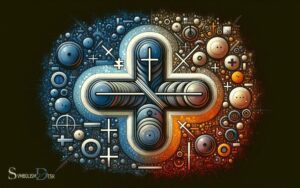What Does the Alpha Symbol Mean in Physics: Object!
In physics, the alpha symbol (α) represents the angular acceleration of an object, which is the rate of change of angular velocity over time. It also denotes the fine structure constant and the alpha particle in nuclear reactions.
The alpha symbol has different meanings depending on the context in which it is used in physics. Primarily, it is used to represent angular acceleration, but it can also be used to signify other physical concepts and constants.
Understanding the meaning of α in a specific context is crucial for accurate problem-solving and interpretation of physical phenomena.
When analyzing the motion of rotating objects, the alpha symbol (α) represents the angular acceleration, which is the rate at which the angular velocity changes with respect to time. It is analogous to linear acceleration in translational motion.
Additionally, α is used to denote the fine structure constant, a dimensionless quantity that characterizes the strength of electromagnetic interactions between charged particles.
In nuclear physics, the alpha particle is a type of ionizing radiation, consisting of two protons and two neutrons, that is emitted during certain types of radioactive decay.
6 Interpretation of Alpha Symbol in Physics
| Context | Alpha Symbol (α) Meaning in Physics |
|---|---|
| Angular Acceleration | α represents the rate of change of angular velocity over time. It’s measured in radians per second squared (rad/s²). |
| Thermal Expansion | α denotes the coefficient of thermal expansion, which describes how the size of an object changes as its temperature changes. It’s typically measured in (1/°C) or (1/K). |
| Fine Structure Constant | α is a fundamental constant in physics that represents the strength of the electromagnetic interaction between elementary charged particles. It is a dimensionless constant approximately equal to 1/137. |
| Alpha Particle | In the context of nuclear physics and radioactivity, α represents an alpha particle, which consists of two protons and two neutrons (essentially a helium-4 nucleus). |
| Alpha Decay | α is used to represent the process of alpha decay, a type of radioactive decay in which an unstable atomic nucleus emits an alpha particle. This process reduces the atomic number by 2 and the mass number by 4. |
| Angles in Trigonometry | In trigonometry, α is often used to represent an angle in a triangle or other geometrical figure. |
Key Takeaway

Five Facts About: The Alpha Symbol in Physics
Defining The Alpha Symbol In Physics And Its Origin
The alpha symbol is an important symbol used in physics, often represented by the greek letter “α”. It has a long history in physics, and its meaning has evolved over time. In classical physics, alpha was used to symbolize acceleration, but in modern physics, it is used to represent various different physical quantities, such as angular acceleration or thermal expansion coefficient. The symbol is also used in mathematics and engineering to denote different concepts and formulas. The greek key pattern explained the complex relationship between alpha and its various meanings in different fields of study.
Below, we will discuss the brief history of the development of the alpha symbol in physics and explain what the symbol signifies in physics.
Brief History Of The Development Of The Alpha Symbol In Physics
- The alpha symbol is the first letter of the greek alphabet, and it was first used to represent the electric resistance in a circuit.
- In 1905, albert einstein used the alpha symbol to represent the fine-structure constant, which is a dimensionless physical constant that characterises the strength of the electromagnetic interaction between charged particles.
- Later, the alpha symbol was used to represent the particle that is emitted during alpha decay, which is a type of radioactive decay.
Explanation Of What The Symbol Signifies In Physics
- The alpha symbol is commonly used in physics to represent various concepts, including the fine-structure constant and the particle emitted during alpha decay.
- The fine-structure constant is a fundamental constant that characterises the strength of the electromagnetic interaction between charged particles. It has a value of approximately 1/137, which means that the strength of the electromagnetic interaction is much larger than other fundamental interactions, such as the weak and strong nuclear interactions.
- The alpha particle, which is emitted during alpha decay, is made up of two protons and two neutrons. It is a highly ionising particle, which means that it can cause significant damage to biological tissues if it is ingested or inhaled.
The alpha symbol is an important symbol in physics that has a long history and a variety of meanings. In physics, the alpha symbol is used to represent various concepts, including the fine-structure constant, the angular acceleration of an object, and the thermal expansion coefficient. Whether it’s used to denote a specific measurement or to represent a fundamental constant, understanding and exploring reading symbols is essential for accurately interpreting and communicating scientific information. Without a clear understanding of symbols like the alpha symbol, it would be impossible to effectively convey complex scientific concepts and theories.
It is used to represent the fine-structure constant, which characterises the strength of the electromagnetic interaction, and the particle emitted during alpha decay. The fine-structure constant, often denoted by the Greek letter alpha (α), is a dimensionless number that plays a pivotal role in the field of quantum electrodynamics. Its influence extends to the fundamental interactions between charged particles and photons, making it a cornerstone of modern physics. Similarly, the particle emitted during alpha decay, known as an alpha particle, is a key concept in nuclear physics and radioactive processes. To ensure safe handling of such materials in educational simulations, hazard symbols on Labster beakers serve as important visual cues, emphasizing the risks and necessary precautions when working with radioactive substances. These symbols are essential for fostering a culture of safety and awareness in laboratory environments.
By understanding the meaning behind the alpha symbol, we can gain a better appreciation for the fundamental concepts of physics.
The Significance Of The Alpha Symbol In Physics
The alpha symbol in physics is an essential concept that carries significant importance in the scientific community.
It is used to describe a variety of phenomena and has a wide range of applications. We will explore the different subfields of physics where the alpha symbol plays a crucial role and its significance in each one.
We will also go in-depth about the alpha particle and its properties.
Explanation Of The Role Of The Alpha Symbol In Various Subfields Of Physics:
The alpha symbol has various meanings depending on the field of physics and context.
These are:
- In thermodynamics, the alpha symbol represents the coefficient of thermal expansion.
- In nuclear physics, the alpha symbol is used to denote the alpha particle, a type of ionizing radiation consisting of two protons and two neutrons bound together.
- In astronomy, the alpha symbol is used to denote the brightest star in a constellation.
- In fluid dynamics, the alpha symbol represents the angle of attack, which is the angle at which a wing meets the oncoming air.
Detailed Description Of The Alpha Particle And Its Characteristics:
The alpha particle is a fundamental particle in nuclear physics. It is made up of two protons and two neutrons, which are held together by the strong nuclear force.
The alpha particle is also known as a helium-4 nucleus and can be represented using the symbol he-4.
Here are some of the characteristics of the alpha particle:
- It has a charge of +2.
- It is relatively heavy compared to other types of ionizing radiation and has a mass of 4 atomic mass units.
- The alpha particle has a short range in matter and can be stopped by a few sheets of paper.
- It is highly ionizing and can cause significant damage to living tissues.
The alpha symbol is a crucial concept in physics that has various applications in different subfields.
Understanding the properties and characteristics of the alpha particle is essential for scientists and researchers in nuclear physics.
Alpha Decay And The Alpha Symbol
The alpha symbol is a widely recognized symbol in the field of physics, particularly in relation to radioactive decay.
As a content writer, let me take you through an overview of alpha decay and its relationship with the alpha symbol in this section of the blog post.
Overview Of Alpha Decay And Its Relationship With The Alpha Symbol
Alpha decay is a process by which an atomic nucleus releases an alpha particle, which is essentially a cluster of two protons and two neutrons.
This process is commonly observed in heavy and unstable atoms, such as uranium. Alpha decay reduces the atomic number of the nucleus by two and the mass number by four.
This process is an essential concept in understanding the behavior of radiation, nuclear energy, and nuclear medicine.
The alpha symbol, α, is used to represent the alpha particle during radioactive decay. It is a greek letter commonly used in physics and appears in a range of equations, including those relating to angular acceleration and wavefunctions.
When referring to alpha decay, the symbol is used to indicate the release of an alpha particle from the nucleus.
Here is an explanation of how the alpha symbol is used to represent alpha particles during radioactive decay.
Explanation Of How The Alpha Symbol Is Used To Represent Alpha Particles During Radioactive Decay
During alpha decay, an atomic nucleus releases an alpha particle and reduces its atomic number by two and mass number by four.
The process follows a specific equation that takes into account various factors such as the stability of the nucleus and energies involved.
- The alpha symbol α is used to represent the alpha particle during the process of radioactive decay. The symbol indicates the emission of the alpha particle from the nucleus.
- The symbol is also used in equations that describe the behavior of alpha particles during decay. For instance, the rutherford scattering equation can be used to describe the trajectory of alpha particles when they interact with matter.
- The symbol is used in other areas of physics, such as in angular acceleration and particle physics. Apart from alpha particles, the symbol also represents other physical quantities, such as coefficients of thermal expansion and fine-structure constant.
The alpha symbol is an essential part of the language of physics. It is a short, simple, and recognizable way to denote alpha particles during radioactive decay and other physical processes.
Understanding the alpha symbol’s role and other concepts related to physics is crucial for anyone interested in knowing more about the universe and its behavior.
Alpha Decay Calculations
The alpha symbol is a common term in physics that describes a steady process of atom nucleus decay. Alpha decay is a type of radioactive decay, where atomic nuclei lose energy by releasing alpha particles.
The alpha particles contain two protons and two neutrons, making them larger than beta particles and gamma rays.
In this blog post, we’ll explore the essentials of alpha decay calculations, including alpha particle energy and decay constant.
In-Depth Look At Alpha Decay Calculations, Including Alpha Particle Energy And Decay Constant
To understand alpha decay calculations, we need to grasp alpha particle energy and decay constant. Here’s an in-depth look at both:
Alpha Particle Energy
Alpha particles are usually emitted by heavier nuclei. As alpha particles are produced, they reflect a specific amount of energy, which is determined by the difference in mass between the parent and daughter nuclei.
The energy varies depending on the shape and size of the nucleus and the condition of the electrons and protons within it.
Thanks to the law of conservation of energy, the sum of the alpha particle energy and its recoil nucleus’ kinetic energy is always equivalent to the nuclear energy decrease.
Therefore, the alpha particle energy can be accurately calculated by knowing the mass and energy of the parent and daughter nuclei.
Decay Constant
The decay constant is the reciprocal of the mean life of an isotope. In other words, it is the probability of a particular nucleus decaying per unit time.
The decay constant can be calculated by comparing the number of parent nuclei to that of daughter nuclei present in a sample.
It’s also essential to note that the decay constant is independent of external factors such as temperature and pressure.
Overview Of The Balance Equation In Nuclear Physics
Nuclear physics involves the study of atomic nuclei and their properties. The balance equation is a fundamental formula in nuclear physics used to describe nuclear reactions that occur within a reaction system.
The equation illustrates the conservation of mass and energy in the reaction.
It is important to maintain balance by balancing the number of atomic and mass units on both sides of the equation.
Here’s an overview of the balance equation:
An example of a balance equation in a nuclear reaction:
- Uranium-235 decays into thorium-231 and alpha particle
- The equation is balanced using mass and atomic number;
- 235 (=92 + 143) = 231 (= 90 + 141) + 4 (= 2 + 2)
Understanding alpha decay calculations is crucial in comprehending nuclear physics. In-depth knowledge of alpha particle energy and decay constant is the basis of understanding alpha decay calculations.
The balance equation is a crucial component in nuclear physics, which must be followed strictly to maintain the conservation of mass and energy in a reaction.
Alpha Particles And Atomic Nuclei
The alpha symbol is used in physics to represent alpha particles – a type of ionizing radiation that consists of two protons and two neutrons, making it identical to a helium-4 nucleus.
In this section, we’ll explore the interaction between alpha particles and atomic nuclei, as well as the significance of alpha particles in studying atomic structure.
Explanation Of How Alpha Particles And Atomic Nuclei Interact
When alpha particles interact with atomic nuclei, they can be scattered in various directions, absorbed, or cause ionizations.
In some cases, the interaction can lead to the emission of secondary particles, such as gamma rays.
The interaction between alpha particles and atomic nuclei can be explained by the electromagnetic force, which causes repulsion between two positively charged particles.
However, at very short distances, the strong nuclear force can overcome the electromagnetic force, resulting in nuclear reactions.
Overview Of The Significance Of Alpha Particles In Studying Atomic Structure
- Alpha particles are commonly used in alpha decay, a type of radioactive decay where a nucleus emits an alpha particle to become a smaller, more stable nucleus.
- By studying alpha decay, scientists can learn more about the internal structure of atomic nuclei and the properties of the strong nuclear force.
- Alpha particles can also be used in nuclear reactions, such as in the fusion of hydrogen nuclei to form helium nuclei. This process is the basis of nuclear fusion, which powers the sun and stars.
- The interaction between alpha particles and atomic nuclei can also be used in nuclear physics research to study the properties and behavior of atomic nuclei.
Alpha particles play a crucial role in our understanding of atomic structure and the behavior of atomic nuclei.
Their interaction with atomic nuclei is governed by the electromagnetic and strong nuclear forces, and their use in nuclear reactions and decay has led to numerous advancements in nuclear physics research.
Alpha Spectroscopy
Alpha spectroscopy: an in-depth description of its applications in atomic physics
As a fundamental concept in physics, the alpha symbol represents the alpha particle, which consists of two protons and two neutrons bound together.
Alpha spectroscopy is a branch of nuclear physics that focuses on the study of this alpha radiation and its interactions with matter.
This technique has numerous applications in atomic physics, including the evaluation of radioactive decay, measurement of the age of rocks and minerals, and the detection of impurities in materials.
In-Depth Description Of Alpha Spectroscopy And Its Applications In Atomic Physics
Alpha spectroscopy entails the measurement of the energy and number of alpha particles emitted during radioactive decay. By using a high-resolution detector, scientists can analyze the energy spectrum of the alpha particles to identify the radioactive decay process.
This technique is particularly useful in identifying the decay of heavy elements, such as uranium and thorium, which emit alpha particles.
Furthermore, alpha spectroscopy is employed in the identification of radon and its decay products in the air.
Alpha particles emitted from radon decay can become trapped in the lungs and lead to significant health problems.
Different Methods Used In Alpha Spectroscopy
There are various methods used in alpha spectroscopy, with each having its strengths and weaknesses.
Some of the commonly used methods include:
- Scintillation counting: This method involves the detection of light emitted when alpha particles interact with a scintillating material. The number of detected photons is proportional to the energy of the alpha particles, allowing for energy spectrum analysis.
- Silicon detectors: These detectors consist of silicon diodes that generate electrical pulses when alpha particles strike them. By analyzing the amplitude and duration of these pulses, scientists can derive information on the energy and number of alpha particles.
- Gas proportional counters: These detectors measure the ionization produced when alpha particles ionize gas atoms. The number of ions generated is proportional to the energy of the alpha particles, allowing for calculation of the energy spectrum.
Alpha spectroscopy is a critical tool used in the study of nuclear physics.
Through its applications in atomic physics, scientists can determine the energy and identity of emitted alpha particles, which aid in numerous fields, including geology, medicine, and environmental science.
Alpha Elements In Space
Alpha particles, also known as helium nuclei, are essential building blocks of the universe. The alpha symbol used in physics represents this type of particle.
Alpha particles are abundant in the cosmos and play a crucial role in the formation of celestial bodies.
In this blog post, we will delve into the importance of alpha elements in space and their contribution to the creation of stars.
Explanation Of The Significance Of Alpha Elements In The Universe
Alpha elements refer to elements with a nucleus that contains two protons and two neutrons, which is the same as the alpha particle’s structure.
These elements are integral to the formation of the universe and serve as the building blocks for everything around us.
Alpha elements are essential because they:
- Contribute to the formation of stars, planets, and ultimately life.
- Help scientists understand the evolution of the universe since they can date the age of celestial bodies using them.
- Shed light on the composition of galaxies and provide clues as to how they formed.
Overview Of How Alpha Particles Play A Role In The Formation Of Stars
Stellar formation is an intricate process that relies on the presence of alpha particles.
Here is an overview of how alpha particles contribute to the creation of stars:
- The universe started with mainly hydrogen and helium, which are both alpha elements.
- Alpha particles combine with hydrogen to form helium-3, which is the fuel that powers nuclear reactions in stars.
- As the star ages, helium-3 continues to combine with hydrogen to create helium-4 and other alpha elements like carbon and oxygen.
- Eventually, the star runs out of hydrogen, and the helium-4 continues to fuse with other alpha particles to make heavier elements like iron.
- When the star exhausts its fuel, it explodes, and the elements it produces become the building blocks for future generations of stars and planets.
The alpha symbol represents one of the most critical particles in the universe.
Alpha elements play a significant role in the formation of stars, from the creation of nuclear fuel to the production of heavier elements that ultimately become the building blocks for life as we know it.
The more scientists can understand these elements, the better they can comprehend the inner workings of the universe.
Alpha Astrophysics
The alpha symbol in physics represents one of the most fundamental particles in the universe. Alpha particles and their behavior are highly researched in astrophysics to gain deep insights into the cosmos’ workings.
In this blog post, we’ll explore the critical role played by alpha particles in astrophysics, leading to groundbreaking discoveries.
In-Depth Look At Alpha Astrophysics And How It Helps In Understanding The Universe
Alpha astrophysics studies the behavior of alpha particles, which are formed of two protons and two neutrons.
These particles are released during nuclear reactions or radioactive decay. Astrophysicists study alpha particles to discover the inner workings of the universe and gather insights into how it formed and evolved.
The study of alpha astrophysics is incredibly important as it helps scientists answer some of the most pressing questions about our universe.
Here are some key points about alpha astrophysics:
- The study of alpha particles helps to better understand the universe’s energy production and consumption mechanisms.
- By analyzing the behavior of alpha particles, astrophysicists can investigate the origins of elements such as carbon and oxygen, which are formed from the fusion of alpha particles.
- Alpha astrophysics helps us to understand how stars are formed, how they evolve, and how they end their lifespan, leading to the creation of different astronomical objects like black holes and neutron stars.
Discussion Of The Significant Discoveries Made Through The Study Of Alpha Particles In Astrophysics
The study of alpha particles has led to many groundbreaking discoveries over the years, including:
- The identification of nuclear reactions involving alpha particles, for instance, the triple alpha process, which is responsible for the formation of carbon in stars.
- The discovery of alpha clustering, where alpha particles can combine to form denser states in atomic nuclei, leading to the production of heavier elements.
- Researching the decay pattern of alpha particles from radioactive elements has helped scientists understand how our atmosphere and life on earth formed.
Alpha astrophysics is not just an exciting field of study, but it’s a critical one that has helped us gain insights into the universe’s fundamental workings.
The knowledge gained provides a foundation for answering key questions and discovering new phenomena.
Scientists are continuing their research into the behavior of alpha particles, and we can expect many more groundbreaking discoveries soon.
Alpha Radiation And Its Applications
Alpha radiation is a type of ionizing radiation that occurs when a nucleus emits a particle composed of two protons and two neutrons.
This particle is called an alpha particle, and it is represented by the greek letter α. alpha radiation is generally considered the least penetrating type of radiation and can be easily stopped by a sheet of paper.
However, it can still be dangerous if inhaled or ingested.
Explanation Of Alpha Radiation And Its Importance In Various Practical Fields
Alpha radiation plays an important role in various practical fields such as:
- Radioactive dating: Alpha decay can be used to estimate the age of materials that contain certain radioactive isotopes like uranium-238 and thorium-232.
- Smoke detectors: Alpha particles are used in smoke detectors to ionize air and detect smoke particles.
- Nuclear power plants: Alpha particles are produced in nuclear reactors and can be used to generate electricity.
- Nuclear medicine: Alpha particles can be used to treat cancer by targeting cancer cells and destroying them.
Overview Of How Alpha Radiation Is Used In Different Industrial And Medical Applications
Alpha radiation is utilized in various industrial and medical applications,
Such as:
- Industrial thickness gauges: Alpha particles can be used to measure the thickness of materials such as paper, plastics, and metal sheets.
- Sterilization of medical equipment: Alpha radiation can be used to sterilize medical equipment by destroying bacteria and microorganisms.
- Cancer therapy: Alpha particles can be used for targeted cancer therapy, where they are delivered directly to cancer cells and destroy them while minimizing damage to surrounding healthy tissue.
- Ion propulsion: Alpha particles can be used in spacecraft propulsion systems to generate thrust.
The alpha symbol represents alpha radiation, which is commonly used in various practical fields.
This type of ionizing radiation is important in industrial and medical applications, including radioactive dating, nuclear medicine, cancer therapy, and sterilization of medical equipment, to name a few.
Is There a Connection Between the Symbolism in Scientology and Physics?
The significance behind the symbolism in Scientology has fascinated many, prompting inquiries into potential parallels with physics. Although controversial, some argue that uncovering the hidden meanings behind the scientology symbol decoded may potentially offer insights into its potential connection with the laws of physics. Whether a genuine link exists or not, the interpretation of these symbols remains a topic of speculation and debate among believers and critics alike.
FAQ About The Alpha Symbol Mean In Physics
What Is The Alpha Symbol In Physics Used For?
The alpha symbol is used to represent and depict the level of transparency or attenuation of a material or medium to particles.
What Is The Significance Of Alpha Decay In Physics?
Alpha decay is significant because it refers to the decay process of an atomic nucleus by emitting an alpha particle, which is a type of ionizing radiation.
How Is The Alpha Radiation Detected In Physics Experiments?
The alpha radiation is detected through various methods, such as using a geiger counter, scintillation detector, or cloud chamber.
What Is The Bohr Model Of The Alpha Particle In Physics?
The bohr model represents alpha particles as the nucleus of a helium atom, consisting of two protons and two neutrons.
How Does The Alpha Symbol Differ From Beta And Gamma Symbols In Physics?
The alpha symbol represents alpha particles, beta symbol represents beta particles or electrons, and gamma symbol represents gamma rays. They differ in their properties and interaction with matter.
Conclusion
The alpha symbol is highly significant in the field of physics, representing different variables and elements. Whether used to denote alpha decay or fine structure constant, the symbol is an essential tool used by physicists in their research.
Understanding its meaning and use is imperative for anyone interested in studying physics or related fields.
As we have discussed, alpha particles and their properties are significant in research involving nuclear materials, while the fine structure constant provides insight into the fundamental aspects of the universe.
The alpha symbol’s use impacts much of the research done in the field of physics, making it essential to have a thorough understanding of its various meanings.
With this knowledge, we can better understand the concepts explored in physics and gain insight into the world around us.






